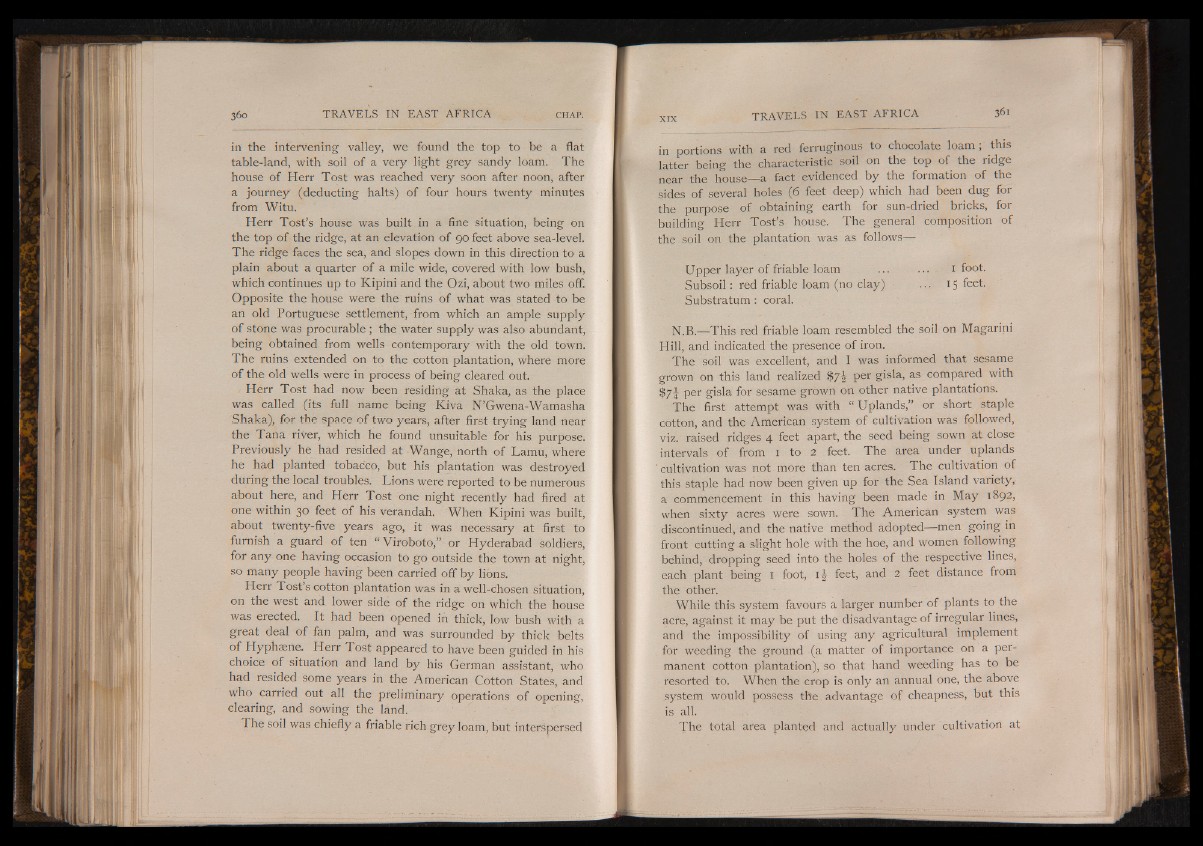
in the intervening valley, we found the top to be a flat
table-land, with soil of a very light grey sandy loam. The
house of Herr Tost was reached very soon after noon, after
a journey (deducting halts) of four hours twenty minutes
from Witu.
Herr Tost’s house was built in a fine situation, being on
the top of the ridge, at an elevation of 90 feet above sea-level.
The ridge faces the sea, and slopes down in this direction to a
plain about a quarter of a mile wide, covered with low bush,
which continues up to Kipini arid the Ozi, about two miles off.
Opposite the house were the ruins of what was stated to be
an old Portuguese settlement, from which an ample supply
of stone was procurable ; the water supply was also abundant,
being obtained from wells contemporary with the old town.
The ruins extended on to the cotton plantation, where more
of the old wells were in process of being cleared out.
Herr Tost had now been residing at Shaka, as the place
was called (its full name being Kiva N’Gwena-Wamasha
Shaka), for the space of two years, after first trying land near
the Tana river, which he found unsuitable for his purpose.
Previously he had resided at Wange, north of Lamu, where
he had planted tobacco, but his plantation was destroyed
during the local troubles. Lions were reported to be numerous
about here, and Herr Tost one night recently had fired at
one within 30 feet of his verandah. When Kipini was built,
about twenty-five years ago, it was necessary at first to
furnish a guard of ten “ Viroboto,” or Hyderabad soldiers,
for any one having occasion to go outside the town at night,
so many people having been carried off by lions.
Herr Tost’s cotton plantation was in a well-chosen situation,
on the west and lower side of the ridge on which the house
was erected. It had been opened in thick, low bush with a
great deal of fan palm, and was surrounded by thick belts
of Hyphaene. Herr Tost appeared to have been guided in his
choice of situation and land by his German assistant, who
had resided some years in the American Cotton States, and
who carried out all the preliminary operations of opening,
clearing, and sowing the land.
The soil was chiefly a friable rich grey loam, but interspersed
in portions with a red ferruginous to chocolate loam; this
latter being the characteristic soil on the top of the ridge
near the house— a fact evidenced by the formation of the
sides of several holes (6 feet deep) which had been dug for
the purpose of obtaining earth for sun-dried bricks, for
building Herr Tost’s house. The general composition of
the soil on the plantation was as follows—
Upper layer of friable loam ... ... 1 foot.
Subsoil: red friable loam (no clay) ... 15 feet.
Substratum : coral.
N.B.— This red friable loam resembled the soil on Magarini
Hill, and indicated the presence of iron.
The soil was excellent, and I was informed that sesame
grown on this land realized $7! Per gisla> as compared with
87 J per gisla for sesame grown on other native plantations.
The first attempt was with “ Uplands,” or short staple
cotton, and the American system of cultivation was followed,
viz. raised ridges 4 feet apart, the seed being sown at close
intervals of from 1 to 2 feet. The area under uplands
cultivation was not more than ten acres. The cultivation of
this staple had now been given up for the Sea Island variety,
a commencement in this having been made in May 1892,
when sixty acres were sown. The American system was
discontinued, and the native method adopted— men going in
front cutting a slight hole with the hoe, and women following
behind, dropping seed into the holes of the respective lines,
each plant being 1 foot, i j feet, and 2 feet distance from
the other.
While this system favours a larger number of plants to the
acre, against it may be put the disadvantage of irregular lines,
and the impossibility of using any agricultural implement
for weeding the ground (a matter of importance on a permanent
cotton plantation), so that hand weeding has to be
resorted to. When the crop is only an annual one, the above
system would possess the advantage of cheapness, but this
is all.
The total area planted and actually under cultivation at